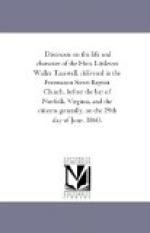youth of one-and-twenty though a married man at that
age, and his bride, a sweet face almost perfectly
reflected in the features of one of his own daughters,
both well executed by the elder Peale, and in good
preservation. There, too, were the portraits of
Col. Nivison and his wife, the parents of Mrs.
Tazewell; of Mr. Tazewell himself by Thompson, the
most intellectual and lifelike of all his portraits,
taken at the age of forty-two; of his wife’s
two sisters, who were the beauties and the belles
of forty-five years ago, and who have long passed away,
and of their brother, the amiable and beloved William
Nivison, whose early death was long deplored by our
people. The general library of Mr. Tazewell was
kept in a separate building, and consisted of his numerous
law books, of the British statutes at large in many
thick quartos, and most of the writers of Queen Anne’s
time and of the Georges, many in the original quarto,
and few or none later than the beginning of the century.
Some of the books had a history of their own.
There was a copy of the Lectures on History, which
Dr. Priestley had presented to Judge Tazewell, the
father of our subject, in memory of the kindness of
the judge to the author when he was flying from the
flames of Birmingham. The beautiful copy of Wilson’s
Ornithology with Bonaparte’s continuation, which
at the date of its publication was one of the most
elegant issues of the American press, had a singular
value in the eyes of Mr. Tazewell as the bequest of
his friend John Wickham, an extract from the will
having been pasted on the fly-leaf of the first volume.
As soon as the visitor fixed his eyes on Mr. Tazewell
all else was forgotten. He was without exception
in middle life the most imposing, and in old age the
most venerable person I ever beheld. His height
exceeded six feet; and until recently, whether sitting
or standing, he was commonly erect, and always when
in full flow. His head and chest were on a large
scale, and his vast blue eye, which always seemed to
gaze afar, was aptly termed by Wirt an “eye of
ocean.” In early youth he was uncommonly
handsome. In middle life he was very thin though
lithe and strong, with a face the outline of which
is very like that of Lord Mansfield. But for
the last thirty-five years, the period during which
I have been familiar with his person, all those traces
of early beauty which had marked his youthful face,
and which in middle life may be seen in the portrait
of Thompson, had disappeared, and he was altogether
on a more developed scale. His stature had become
large, his features were massive, his silver hair
fell in ringlets about his neck, and his bearing was
grave, and with strangers, until the ice was broken,
almost stern; and he appeared with a majesty which
filled the most careless spectator with veneration
and awe. And when we add to these the overshadowing
reputation universally accorded him, we can readily
imagine the solicitude with which the most eminent




